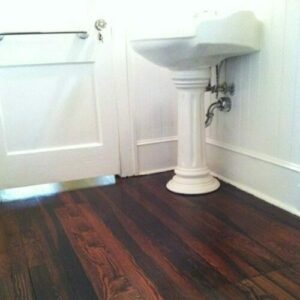
If you have hardwood floors in your old house, the chances are good that they are coated with a protective layer of polyurethane.
Today, polyurethane is by far the most popular finish choice for wood floors. Here’s what you need to know.
Polyurethane, while not revered by woodworkers and furniture makers, is usually the best choice for the harsh conditions and traffic your floors have to endure.
Ultimately, whichever type of polyurethane you use the most important part is how you care for your floors. You can learn all about How To: Care For Hardwood Floors in my earlier post.
Oil-based vs Waterborne
There are generally two types of polyurethane, waterborne and oil-based. The performance can be quite different between these two as is the application.
Oil-based Polyurethane
-
- Slower dry time (18-24 hrs before normal foot traffic)
- Ambers slightly with age
- Mineral spirits cleanup
- Thick, hard finish well-suited for heavy traffic areas
- High VOC content and strong odor
- $20-35 per gallon
- Industry standard is 3 coats of finish on floors
Oil-based polyurethane is still the industry standard for wood floor refinishing. While some of these may seem like negatives, that is not necessarily the case. A slower drying time allows easier application and better leveling, which provides an exceptionally smooth finish. The ambering of the finish adds a warmth to the wood and the thicker formula means less coats and more protection for your money.
Waterborne Polyurethane
-
- Dries quickly (5-7 hrs before normal foot traffic)
- Dries crystal clear with no noticeable color
- Water cleanup
- Thinner finish that is not quite as resilient as oil-based formulas
- Low VOC and minimal odor
- $40-70 per gallon
- Industry standard is 4 coats of finish on floors
Waterborne finishes are getting better and better every year, and for light woods like maple, I prefer them because they give a flawlessly clear finish. The ease of water cleanup can’t be ignored either. Of course, the quicker drying time makes application less forgiving and it’s easy to get brush marks if you’re not careful.
Spar Urethane
There is another category of polyurethane that I should mention called spar urethane. This type of polyurethane is designed for exterior use (doors, thresholds, etc.) Spar urethane has two main differences:
- Contains UV inhibitors to protect it from the sun
- More flexible finish (not as hard) than traditional polyurethane to allow for increased expansion and contraction that occurs in exterior environments.
Spar urethane isn’t a great choice for your wood floors, but for covered porch flooring, exterior doors and thresholds it is the best option.
Choosing Your Gloss Level
Polyurethane comes in three gloss levels typically. Gloss, Semi-gloss and Satin. The gloss level does not affect performance of the finish and so it is really just a matter of personal preference.
For historic homes, I usually recommend Satin or Semi-gloss. A Satin finish hides marks and imperfections better than its higher gloss cousins. Ultimately, the choice is yours.
The application of polyurethane is beyond the scope of this post because it can be quite difficult. Getting a professional finish with polyurethane is a bit of the right technique and a lot of science. Drying times are greatly affected by temperature, humidity, air flow and a host of other conditions. A bad application can result is streaks, bubbles or fish-eyes (spots where finish doesn’t adhere properly).
Now that you nderstand the finish options for your floors, you can be better prepared. And when the time comes to refinish, you’ll know exactly what to tell your refinisher.

Founder & Editor-in-Chief
I love old houses, working with my hands, and teaching others the excitment of doing it yourself! Everything is teachable if you only give it the chance.


Each polyurethane is unique, thanks to tweaks in its chemical makeup; choose the one that best matches your particular project.
Nice post! Thanks for share.